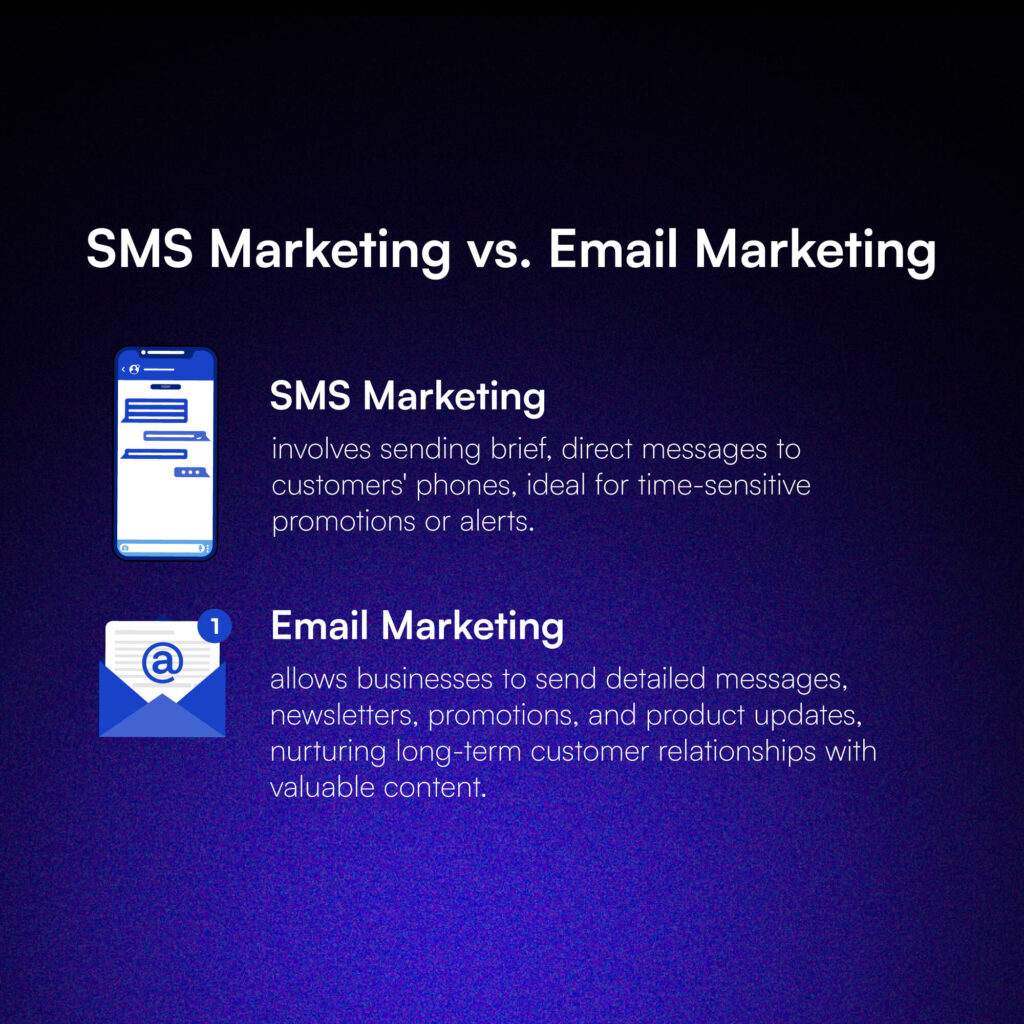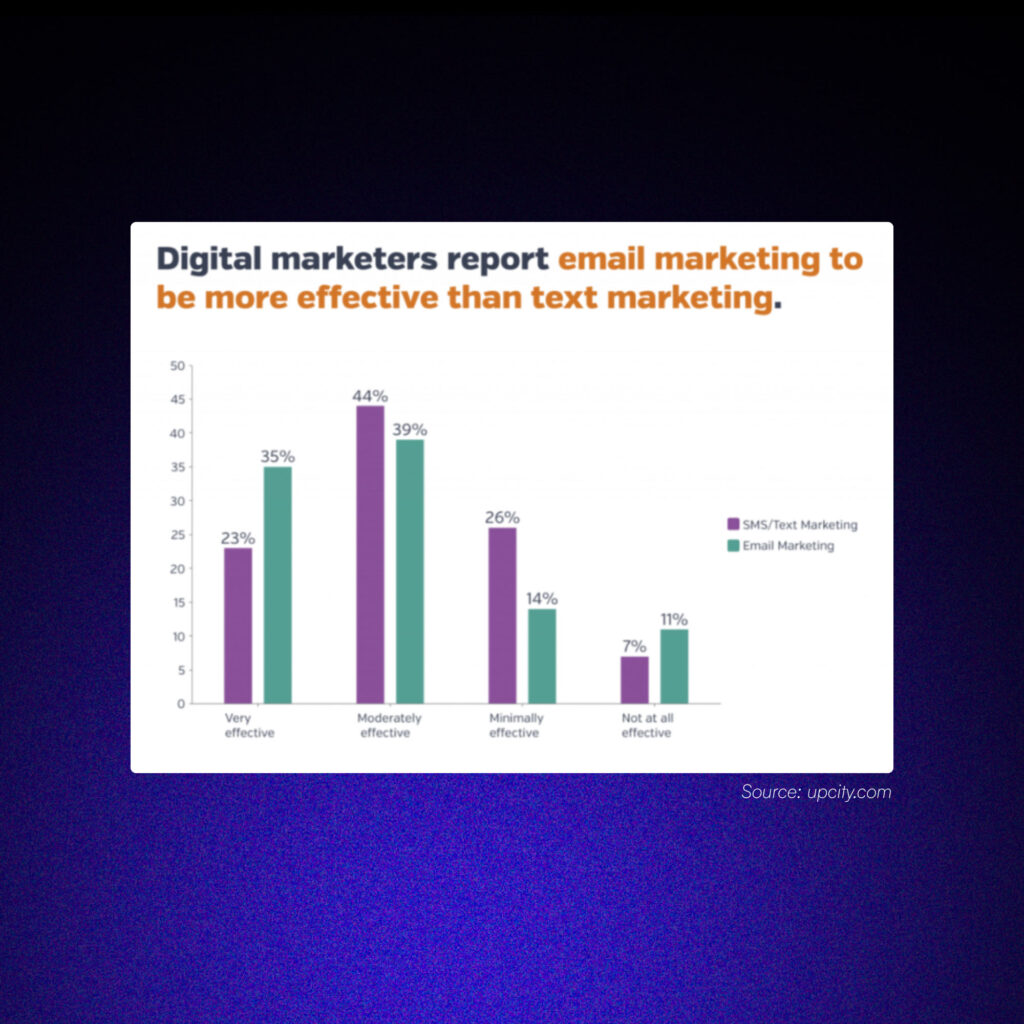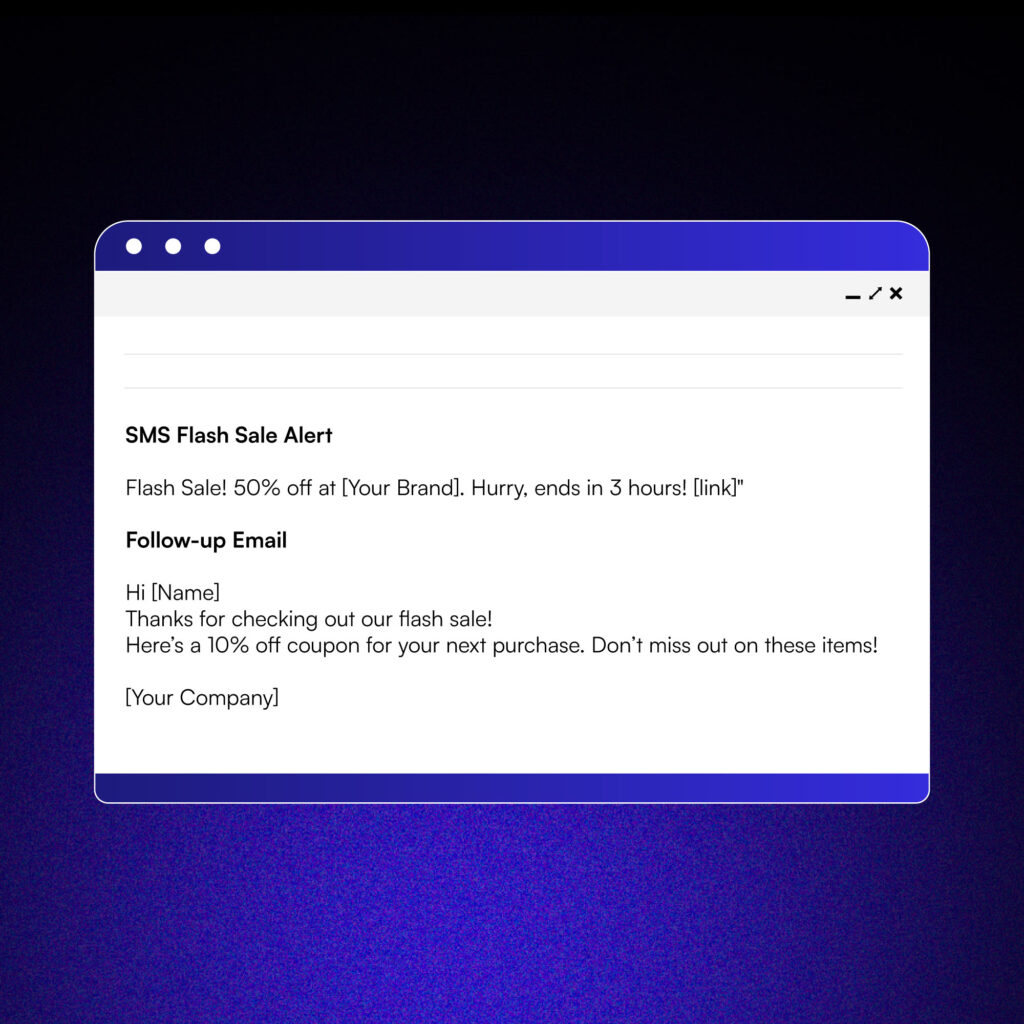Understanding SMS Marketing vs Email Marketing
Before we dive into the comparison, let’s first define SMS and email marketing in the context of e-commerce.
SMS Marketing
This involves sending text-based messages directly to customers’ mobile phones. It’s quick, direct, and personal, making it ideal for short, time-sensitive promotions or alerts.
Customers receive SMS messages instantly, and the communication tends to feel more immediate and engaging.
Email Marketing
On the other hand, enables businesses to send more detailed messages, newsletters, promotions, and product updates.
Email is perfect for nurturing long-term customer relationships and delivering valuable content over time. While email might take longer to read, it allows for richer content with visual elements, links, and detailed information.

Key Features: SMS Marketing vs Email Marketing
SMS marketing vs email marketing , wondering what are their distinct features that make them valuable for e-commerce?
Let’s explore their unique benefits.
SMS Marketing Features
- Instant Delivery: Imagine needing to get a message to your customers immediately—perhaps about a flash sale or an urgent update. SMS is your go-to channel for this. Text messages are delivered instantly, ensuring your audience receives your communication right away.
- High Open Rates: Did you know that SMS messages boast an impressive open rate of around 98%? This means your messages are almost guaranteed to be seen.
- Concise Communication: With SMS, you’re limited to 160 characters. While this might seem restrictive, it actually encourages you to get straight to the point. It’s perfect for time-sensitive promotions like flash sales, limited-time offers, or order updates.
- Personal and Direct: There’s something inherently personal about receiving a text message. Since SMS goes directly to a customer’s phone, it feels more intimate, often leading to quicker responses and higher engagement.
Email Marketing Features
- Detailed Content: Emails enable the delivery of comprehensive messages enriched with product images, in-depth descriptions, and personalized offers, allowing for a more engaging presentation to your audience.
- Automation Capabilities: Modern email marketing platforms support full automation, facilitating the dispatch of personalized welcome emails, abandoned cart reminders, and follow-up offers. This automation streamlines processes, saving time and boosting efficiency.
- Segmentation: Advanced segmentation features allow for dividing your audience based on behaviors, demographics, and purchase history. This ensures that your messages are precisely tailored to each customer segment, enhancing relevance and engagement. Platforms like Klaviyo and Mailchimp offer robust segmentation tools to help you target your audience effectively.
- Analytics and Optimization: Robust analytics tools provide insights into key metrics such as open rates, click-through rates, and conversions. This data-driven approach enables the optimization of campaigns for improved results.
Pros and Cons of SMS Marketing
While SMS marketing has powerful advantages, it also has some drawbacks that should be considered.
Pros of SMS Marketing
- Instant Communication: SMS messages are typically read within minutes of being sent, making them ideal for urgent communication.
- High Engagement Rates: Due to the immediacy of SMS, customers are more likely to engage with messages, especially when they contain time-sensitive offers.
- Mobile-Friendly: Since nearly everyone has their phone with them, SMS is perfect for reaching customers on the go.
- Improved Response Rates: SMS campaigns see response rates as high as 45%, which is significantly higher than most email campaigns (around 6%).
Cons of SMS Marketing
- Character Limits: SMS messages are restricted to 160 characters, meaning that content must be concise, limiting the amount of information you can deliver.
- Potential for Annoyance: Over-sending SMS messages can irritate customers and lead to opt-outs.
- Privacy Concerns: Some customers are hesitant to share their phone numbers, which can limit your reach, especially if you don’t already have a phone number database.
Pros and Cons of Email Marketing
Email marketing has long been a staple of digital marketing strategies, but it also has its own set of strengths and weaknesses.
Pros of Email Marketing
- Detailed Communication: With email, you can deliver more in-depth information, including images, links, and personalized content.
- Scalability: Email marketing can be highly scalable, making it an excellent option for growing businesses. You can send thousands of emails at once and automate the process to save time.
- Cost-Effective: Compared to other marketing methods, email marketing is incredibly cost-efficient, offering businesses a high ROI, particularly for large-scale campaigns.
- Higher Long-Term ROI: Businesses typically see an average ROI of 42:1 for every dollar spent on email marketing, which is one of the highest ROI figures in digital marketing.
Cons of Email Marketing
- Lower Open Rates: While email marketing is still effective, its open rates tend to be lower than SMS. With a typical open rate of around 20%, standing out in crowded inboxes can be challenging.
- Spam Filters: Emails may get caught in spam filters, reducing their visibility and engagement.
- Slower Response Times: Unlike SMS, emails often have a slower response time, especially for non-urgent content.
Which Delivers Better ROI for E-commerce?
Let’s take a look at how SMS marketing vs email marketing stack up when it comes to ROI for e-commerce businesses.
SMS Marketing ROI
- Higher Engagement: SMS messages often prompt immediate action. A customer is more likely to act on a flash sale, discount, or urgent offer delivered via SMS.
- Cost-Effectiveness: While SMS campaigns can be costly in terms of per-message fees, their higher engagement and immediate impact often offset these costs.
Email Marketing ROI

- Effortless Scalability & Automation: Email marketing helps e-commerce brands maximize ROI by automating key touchpoints in the customer journey. Such as: abandoned cart emails recover lost sales, welcome sequences drive first-time purchases, and personalized product recommendations to increase average order value. All these without constant manual effort. This means more revenue with less work.
Building Customer Loyalty for Long-Term Growth: Unlike one-time SMS alerts, email keeps customers engaged long after their first purchase. Regular newsletters, exclusive promotions, and loyalty rewards encourage repeat business. It increases customer lifetime value (CLV) and makes each customer more profitable over time.
- The bottom line? A strong email marketing strategy doesn’t just generate quick sales—it creates a sustainable revenue stream for your e-commerce business.
Transactional Emails vs. Marketing Emails
SMS Marketing vs Email Marketing: How They Can Work Together?
- Use SMS for Urgent Messages: SMS is perfect for time-sensitive promotions, such as flash sales, limited-time offers, or urgent product updates.
- Use Email for Long-Term Engagement: For non-urgent promotions, product recommendations, and loyalty programs, email is the better channel. It allows you to build more detailed, personalized communication with your audience.
- Integrate Both Channels: An excellent way to combine SMS and email marketing is by using them sequentially.
Example of SMS and Email Working Together
By using SMS for immediate action and email for post-purchase engagement, you create a seamless experience for your customers, maximizing both short-term conversions and long-term loyalty.



